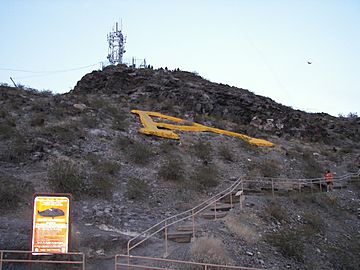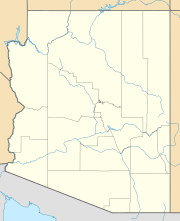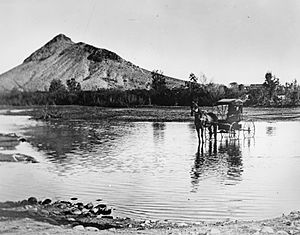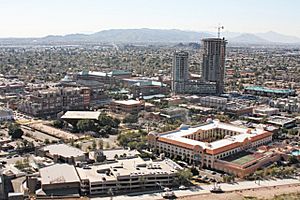Tempe Butte facts for kids
Quick facts for kids Tempe Butte |
|
|---|---|
| "A" Mountain O'odham: ʼOidbaḍ Doʼag |
|

Tempe Butte, or A Mountain, is a popular place to hike as it provides a view of ASU's Tempe campus and downtown Tempe.
|
|
| Highest point | |
| Elevation | 1,495 ft (456 m) NAVD 88 |
| Prominence | 330 ft (100 m) |
| Geography | |
| Location | Tempe Maricopa County, Arizona, U.S. |
| Topo map | USGS Tempe |
Tempe Butte is the official name for a cool hill in Tempe, Arizona. It's made from volcanic rock and sits partly on the Arizona State University (ASU) campus. People often call it A Mountain because of the big gold letter 'A' near its top. The city of Tempe also calls it Hayden Butte.
The highest point of Tempe Butte is about 1,495 feet (456 meters) high. Its base is around 1,150 feet (351 meters) high.
You might have seen Tempe Butte in the background of games at Sun Devil Stadium. This includes past events like the Fiesta Bowl and even Super Bowl XXX.
Contents
What is Tempe Butte Made Of?
Tempe Butte was once a series of flat rock layers. Over a very long time, these layers tilted. Erosion then shaped the hard volcanic rock into the distinctive hill you see today. It stands over softer rock and sand.
Plants and Animals of Tempe Butte
Even with lots of buildings nearby, Tempe Butte is home to many native plants. You can find tall saguaro cacti, spiky buckhorn cholla, and round barrel cactus. Other plants include creosote bush, wolfberry, and mormon tea.
In spring, colorful flowers bloom. These include different types of lupine, globemallow, and popcorn flowers. In summer, wild buckwheat blooms. When it dries, it leaves behind a "skeleton" shape.
Small desert animals also live here. You might spot jackrabbits hopping around. There are also tiny pack rats, which are good at living in the desert.
History of Tempe Butte
People have lived near Tempe Butte for a very long time. The Hohokam people lived here in the past. They left behind petroglyphs (rock carvings), pottery pieces, and tools.
In the 1870s, a community grew just west of the butte. It was first called Hayden's Ferry. This was a main crossing point for the Salt River, which flows north of the butte. A man named Darrell Duppa thought the area looked like the beautiful Vale of Tempe in Greece. That's how the town got its name, Tempe.
The old Hayden Flour Mill, which gave its name to Mill Avenue, still stands near the butte.
Over the years, some changes have been made to the butte. Two water tanks were built on its south side. Trails, some paved, were added to reach man-made structures. Part of the east side was dug out to build Sun Devil Stadium in 1958. A radio tower was built on top in 1962, but it was removed in 2019.
People are working to protect the butte from more changes. This is especially true with new buildings along the Salt River, which is now Tempe Town Lake.
The Famous "A"
The letter on Tempe Butte has changed over time. It was first an 'N' in 1918 for Tempe Normal School. When the school changed its name, the letter became a 'T'.
In 1938, the first 'A' appeared, made from loose rocks. Students started a tradition of painting the 'A' white each fall. In 1952, vandals destroyed the 'A'. The 'A' you see today was built in 1955. It's made of strong steel and concrete and stands 60 feet (18 meters) tall.
There's also an "A Mountain" for the University of Arizona (UA) in Tucson. Because of this, students from ASU and UA sometimes try to paint the other school's 'A' in their own colors. Guarding the 'A' is a tradition before the annual ASU-UA football game, known as the Territorial Cup.
The 'A' is usually painted gold, one of ASU's school colors. It's painted white at the start of each school year. Sometimes, it's painted other colors for special reasons. For example, UA students painted it red and blue in 2014. Other schools, like the Oregon Ducks and Grand Canyon University, have also painted it their colors.




